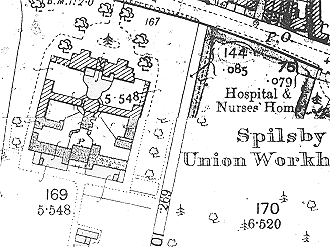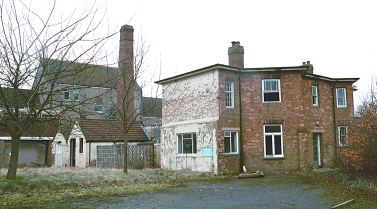Spilsby, Lincolnshire
Up to 1834
A workhouse or poorhouse was established in 1640 by the parish of Hogsthorpe. It was located almost a mile to the north-east of the village, on what is still known as Workhouse Lane. It had closed by 1831, when it was converted into nine cottages. The building, now known as Rosebay (or Roase Bay), is still in residential use.
A parliamentary report of 1777 recorded parish workhouses in operation at Alford, for up to 15 inmates, and at Bolingbroke, for up to 40.
Eden, in 1797, reported on poor-relief in Spilsby:
Eden also reported on the parish of Alford:
A workhouse was established at Winthorpe in about 1820. Newspaper advertisements were placed for a person to manage the establishment and take charge of the poor.
In 1829, a contractor was being sought to run the workhouse at Wainfleet, which served the parishes of Wainfleet St Mary, Wainfleet All Saints, Northolme, and several other adjoining parishes.
A workhouse stood on Workhouse Lane, off Wigg Lane, at Chapel St Leonards.
Until the 1930s, a property now known as the Limes, on Quadring Road, Donington, was desgnated on maps as Workhouse Farm.
After 1834
Spilsby Poor Law Union was formed on 13th April 1837. Its operation was overseen by an elected Board of Guardians, 69 in number, representing its 66 constituent parishes as listed below (figures in brackets indicate numbers of Guardians if more than one):
County of Lincoln:
Addlethorpe, Alford (2), Anderby, Ashby, Aswarby, Bilsby with Thurlby, Bolingbroke, Bratoft, Brinkill, Burgh in the Marsh, Calceby, Candlesby, Claxby, Croft, Cumberworth, Dalby-cum-Dexthorp, Driby, Farlesthorpe, Firsby, Friskney (2), Gunby, Hagnaby, Halton Holgate, Hareby, Harrington, Hogsthorpe, North Holme, Huttoft, Hundleby, Ingoldmells, Irby in the Marsh, East Kirkby, East Keal, West Keal, Langton by Spilsby, Markby, Mavis Enderby, Mumby with Chapel Mumby, Orby, South Ormsby with Ketby, Partney, Raithby, Rigsby with Ailsby, Sansthorpe, Scremby with Grebby, Skegness, Skendleby, Spilsby (2), Great Steeping, Little Steeping, Stickford, Stickney, Sutterby, Sutton in the Marsh, Thorpe, Toynton All Saints, Toynton St Peter's, Ulceby with Forthington, East Ville, Mid Ville, Wainfleet All Saints, Wainfleet St Mary, Well and Derthorpe, Welton in the Marsh with Boothby, Willoughby, Winthorpe.
Later additions: Chapel St Leonards (from 1896), New Leake (1894), Northholme (1837), West Fen (1880).
The population falling within the Union at the 1831 census had been 23,316 — ranging from Sutterby (population 31) to Alford (1,784) and Spilsby itself (1,384). The average annual poor-rate expenditure for the period 1834-36 had been £14,822 or 12s.9d. per head.
Spilsby Union workhouse was built in 1837 at the south side of the Hundleby Road to the west of Spilsby. Intended to accommodate 260 inmates, its construction cost £around £3,500. The architect was George Gilbert Scott who, together with his partner William Bonython Moffatt, designed the workhouses at Boston, Horncastle and Louth.
The Spilsby design followed Scott's typical plan with an arched single-storey entrance block, three-storey main accommodation block, and small infirmary and ancillary buildings to the rear. The workhouse layout can be seen on the 1904 map below.

Spilsby workhouse site, 1904.
After 1930, the former workhouse became a Public Assistance Institution. Its accommodation was supplemented by 35 places at West Keal Hall, located a couple of miles to the south-west pf Spilsby. After 1948, the hospital facilities became the Gables Hospital, which provided geriatric care.
All that now remains of the building is the central portion of the main block.

Spilsby main block from the north-east, 2001.
© Peter Higginbotham.
Staff
Inmates
Records
Note: many repositories impose a closure period of up to 100 years for records identifying individuals. Before travelling a long distance, always check that the records you want to consult will be available.
- Lincolnshire Archives, St. Rumbold Street, Lincoln LN2 5AB. Relatively few records survive. Holdings include Guardians' minute books (1837-72, 1876-1930); Assessment committee minutes (1862-1927); etc.
Bibliography
- Higginbotham, Peter The Workhouse Encyclopedia (2014, The History Press)
Links
- None.
Unless otherwise indicated, this page () is copyright Peter Higginbotham. Contents may not be reproduced without permission.


